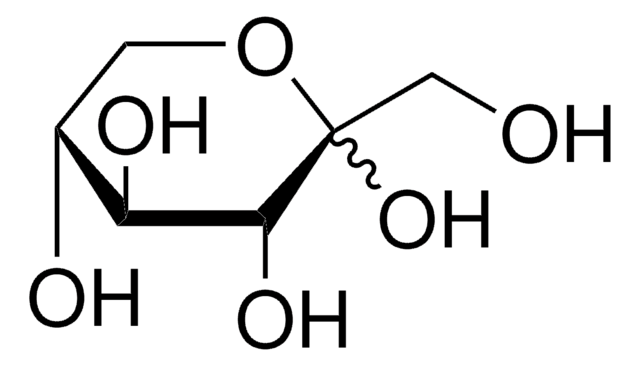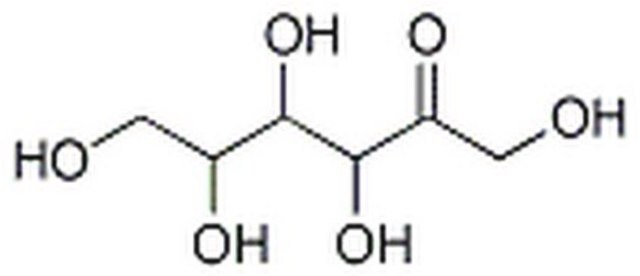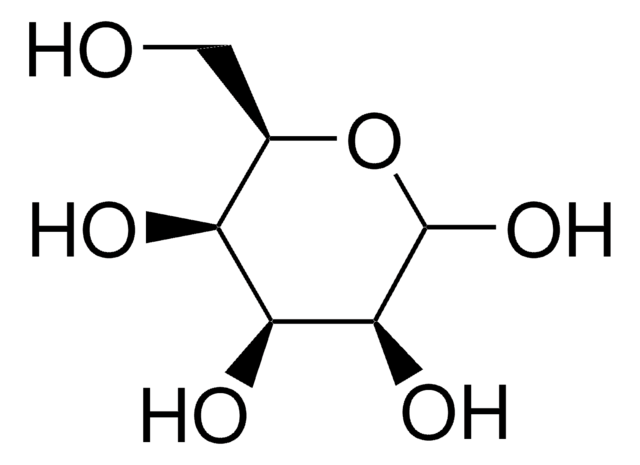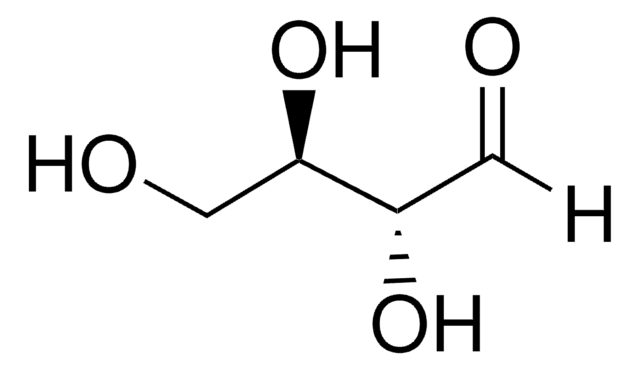85541
L-(−)-Sorbose
for biotechnological purposes, ≥98.0% (sum of enantiomers, HPLC)
Sign Into View Organizational & Contract Pricing
All Photos(1)
About This Item
Empirical Formula (Hill Notation):
C6H12O6
CAS Number:
Molecular Weight:
180.16
Beilstein/REAXYS Number:
1724554
EC Number:
MDL number:
UNSPSC Code:
12352201
PubChem Substance ID:
NACRES:
NA.25
Recommended Products
Quality Level
assay
≥98.0% (sum of enantiomers, HPLC)
form
solid
optical activity
[α]20/D −43±2°, c = 5% in H2O
color
colorless
mp
163-165 °C
solubility
H2O: 0.1 g/mL, clear, colorless to very faintly yellow
SMILES string
OC[C@H](O)[C@@H](O)[C@H](O)C(=O)CO
InChI
1S/C6H12O6/c7-1-3(9)5(11)6(12)4(10)2-8/h3,5-9,11-12H,1-2H2/t3-,5+,6+/m0/s1
InChI key
BJHIKXHVCXFQLS-OTWZMJIISA-N
Looking for similar products? Visit Product Comparison Guide
application
L-Sorbose is used as a starting reagent for the commercial biosynthesis of ascorbic acid (vitamin C).
Biochem/physiol Actions
The L enatiomer of sorbose, a ketohexose monosaccharide.
Other Notes
To gain a comprehensive understanding of our extensive range of Monosaccharides for your research, we encourage you to visit our Carbohydrates Category page.
Storage Class
11 - Combustible Solids
wgk_germany
WGK 3
flash_point_f
Not applicable
flash_point_c
Not applicable
ppe
Eyeshields, Gloves, type N95 (US)
Choose from one of the most recent versions:
Already Own This Product?
Find documentation for the products that you have recently purchased in the Document Library.
Customers Also Viewed
Raquel Barajas-Azpeleta et al.
PLoS genetics, 14(10), e1007440-e1007440 (2018-10-13)
Antimicrobial peptides act as a host defense mechanism and regulate the commensal microbiome. To obtain a comprehensive view of genes contributing to long-term memory we performed mRNA sequencing from single Drosophila heads following behavioral training that produces long-lasting memory. Surprisingly
Hans K Carlson et al.
The ISME journal, 14(8), 2034-2045 (2020-05-07)
Respiratory and catabolic genes are differentially distributed across microbial genomes. Thus, specific carbon sources may favor different respiratory processes. We profiled the influence of 94 carbon sources on the end products of nitrate respiration in microbial enrichment cultures from diverse
Xiaoyu Shan et al.
Frontiers in bioengineering and biotechnology, 8, 194-194 (2020-04-08)
2-Keto-L-gulonic acid (2-KLG) is the direct precursor for the production of L-ascorbic acid (L-Asc) on industrial scale. Currently, the production of L-Asc in the industry is a two-step fermentation process. Owing to many unstable factors in the fermentation process, the
Cai-Hui Pan et al.
Journal of industrial microbiology & biotechnology, 44(7), 1031-1040 (2017-03-12)
Defect in the amino acid biosynthetic pathways of Ketogulonicigenium vulgare, the producing strain for 2-keto-L-gulonic acid (2-KGA), is the key reason for its poor growth and low productivity. In this study, five different strains were firstly reconstructed by expressing absent
Yue Chen et al.
Frontiers in bioengineering and biotechnology, 7, 385-385 (2020-01-11)
High-throughput screening is a powerful tool for discovering strains in the natural environment that may be suitable for target production. Herein, a novel enzyme-based high-throughput screening method was developed for rapid screening of strains overproducing 2-keto-L-gulonic acid (2-KLG). The screening
Our team of scientists has experience in all areas of research including Life Science, Material Science, Chemical Synthesis, Chromatography, Analytical and many others.
Contact Technical Service













